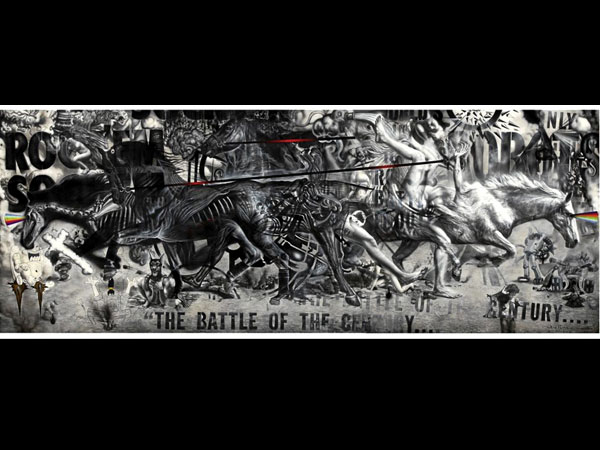
Editor’s Note: In 2011, Lifestyle wasn’t so much about style as critical, controversial issues, starting with an art exhibit that was deemed sacrilegious.
By Lito Zulueta, Gibbs Cadiz, Cheche V. Moral, Vangie Baga-Reyes, Alya Honasan
1. Ronald Ventura becomes biggest-selling Southeast Asian ‘new’ artist
Emerging Filipino artist Ronald Ventura became the biggest selling contemporary Southeast Asian artist when his painting, “Grayground,” sold for HK$8,420,000, or P46.9 million (US$1.1 million), 24 times its original high estimate of HK$300,000, on April 4, during the Sotheby’s Modern and Contemporary Southeast Asian Paintings auction.
The huge, largely monochromatic work—a graphite, oil and acrylic on canvas—was six ft in width and four meters in length and combined hyperrealism and graffiti in depicting galloping horses seemingly at war with each other, a commentary, the Sotheby’s catalogue said, “on how art should be.”
Despite the baffling symbolism, there was no doubt that the work exhibited solid draftsmanship, mastery of anatomy and dynamic composition, so that it drew fierce bidding. Fifteen groups bid on the phone and all together, there were 50 bids made before the auction master banged the gavel to declare the work finally sold.
With the sale, the 38-year-old Ventura has become the biggest selling “new” or contemporary Southeast Asian artist, beating the record set by Indonesian artist I Nyoman Masriadi’s “The Man from Bantul (The Final Round),” which sold for HK$7,800,000 (US$1,000,725) in 2008.
2. Rodel Tapaya wins grand prize in Asia-Pacific art contest
Another Filipino new artist, Rodel Tapaya, consolidated the reputation of Philippine contemporary art in Asia when he won on Nov. 17, the grand prize in the triennial Asia-Pacific Breweries Foundation Signature Art Prize, for a 305 x 610-cm acrylic on canvas mural that weaves ancient Philippine myths and folklore with current realities, such as environmental degradation and flooding.
Tapaya’s work, “Baston ni Kabunian, Bilang Pero ’Di Mabilang (Cane of Kabunian, Numbered but Cannot Be Numbered),” bested 14 other mainly large-scale art installations from 14 countries across the Asia-Pacific.
The 31-year-old Tapaya, the youngest among the finalists, received 45,000 Singapore dollars (around P2 million).
“With its multiple narratives and diverse allegorical references, this stunning mural-sized painting embodies a vibrant strain in contemporary art from the Asia-Pacific region,” the international jury said.
3. Uproar over ‘sacrilegious’ art work forces closure of CCP exhibit
An art installation that included Catholic images and a huge crucifix dotted with penises caused what could be the loudest uproar in the Philippine art scene for years to come, causing the closure of the exhibit at the Cultural Center of the Philippines last August.
Mideo Cruz, the artist responsible for the installation, “Politeismo (Polytheism),” said his work was a commentary on icon worship. But Catholic groups said his work was an attack against religion and demanded the work be pulled out. Although the CCP resisted at first, it later caved in, citing security threats.
Liberal groups criticized the Catholic groups, insisting that freedom of expression and the freedom of the artist should be respected. But Catholic groups said the exhibit was mounted in a state agency, and the state should not sponsor a work that attacks religion.
Inquirer columnist Randy David tried to have an even-handed view of the matter. “It is good for the art system to invoke constitutional guarantees for freedom of expression,” he wrote. “But, it cannot hope to secure its autonomy by free-riding on the legal system.”
He said the art world cannot just irritate religion and other social systems while invoking its prerogatives, in the process “fetishizing rights.”
He said art should know “how to balance assertion and restraint while strengthening its authority within its own domain.”
4. Puey Quiñones retagging scandal
The scandal created by fashion designer Puey Quiñones’ retagging of a men’s suit intended for a wedding client brought to light what many already knew but were too afraid to talk about on record: that some fashion designers are guilty of deceitful and unprofessional practices.
The story began when a client discovered that Quiñones had retagged an off-the-rack men’s suit and passed it off as bespoke—and thus priced many times more than the suit’s actual department-store price. The story quickly went viral online.
Cornered, Quiñones owned up to his mistake and apologized to the couple, promising to reimburse them.
But that wasn’t the end of the story. Other supposed Quiñones clients began relating their own Designer Dearest stories on blogs and social networking sites, besmirching an industry that is all about gloss and glamour. Soon enough, there were accounts of misdeeds by other prominent fashion designers. The stories are convoluted and horrific: wedding dresses that fall apart, barong Tagalogs with plunging necklines, late deliveries, unmet contract specifications, etc.
On designers’ defense, veteran designer Auggie Cordero said in some cases, the clients are partly to blame for, say, ill-fitting clothes: They don’t show up for fittings or gain weight. Fashion designers, he said, aren’t magicians.
A postscript: Bergamo, the formal men’s wear boutique that employed Quiñones, severed ties with the designer when a client from overseas complained of another transgression.
5. Philippine Volcanoes billboard brouhaha
Lifestyle brand Bench created a stir not when it put up its multi-panel billboards featuring the national rugby team, but when they were taken down on the behest of two metro mayors.
Valenzuela Mayor Sherwin Gatchalian called Mandaluyong Mayor Benhur Abalos’ attention to the billboards, describing them as offensive and inappropriate. It showed the athletes in their underwear, who were posing for Bench Body, the brand’s underwear label. The billboards were on a prominent part of Edsa, on Guadalupe bridge, which is under Abalos’ jurisdiction,
Even as he complied with Abalos’ “request,” Bench boss Ben Chan expressed his disappointment over the order. “Apparently they are empowered to suddenly remove the billboards if they feel they have ‘just cause,’” he told the Inquirer. Chan reasoned the billboards didn’t violate any law and were “screened according to the prescribed guidelines of what is permissible to be shown to the public.”
Edsa billboards are major advertising tools for brands. “If well-positioned, you get exposure in the few seconds a motorist passes by,” said George Siy, president of Marie France, Facial Care Center and Svenson, who came to the defense of advertisers.
The ruckus resulted in the revision of guidelines showing skin on ads.
https://lifestyle.inquirer.net/5061/billboards-of-scantily-clad-rugby-players-pulled-down
6. Weekend market vendors
The weekend markets located strategically around Metro Manila remain to be the most talked-about and frequently visited places among foodies and non-foodies. Their number is fast-growing. To name some: Mercato Centrale in Bonifacio Global City; Sidcor at Eton Centris Walk, QC; Weekend Gourmet Market in Eastwood City; Salcedo Market, Salcedo Park, Makati; Legazpi Sunday Market, Legazpi Village, Makati; Soderno Weekend Market in Alabang; Banchetto in Ortigas Center; AANI Organic Market in Taguig; Foodtown Weekend Market, Megatent Events Venue, Pasig; Northeast Greenhills Sunday Market, San Juan.
Vendors offer fresh produce and cooked food. There’s also a visual feast of grilled meats—pork barbecue, skewered bacon and beef tapa. There is a variety of organic and ready-to-eat food from new entrepreneurs and weekend home bakers themselves.
https://lifestyle.inquirer.net/104/weekend-wonders
7) Filipinos win in international cookfests
Filipino chefs and culinary students have brought national pride as they competed this year at the Hong Kong International Culinary Classic (Hofex edition) in HK, the region’s leading food and hospitality trade show. Over 500 chefs from the region joined.
Filipino ingenuity again won rave after rave for their gustatory creations. Members of the Pastry Alliance of the Philippines bagged at least five gold medals, winning top prize in every category they joined—from pastry showpiece, wedding cakes, linger and plated desserts to chocolate fragrant tea cake category, live bakery and fantasy table.
Other winning teams came from Global Culinary and Hospitality Academy, Center for Culinary Arts-Manila (CCA), and Magsaysay Institute of Hospitality and Culinary Arts (Mihca), among others.
https://lifestyle.inquirer.net/1815/filipinos-cook-up-a-storm-in-hk-cookfest
8) Two titans orphaned the theater scene this year
Jose Mari Avellana in June; and National Artist for Theater Design Salvador Bernal in October.
Avellana, 70, an eminent actor-director-producer, was the scion of two National Artists for Theater—Lamberto Avellana and Daisy Hontiveros-Avellana (at 94 this year, one of the last remaining links to the dawn of modern Philippine theater in the 1930s). His last production was the 2009 Repertory Philippines revival of Nick Joaquin’s “A Portrait of the Artist as Filipino,” which he directed.
Bernal left local theater an indelible legacy with his trailblazing, decades-long body of work on scenery and costumes for plays, musicals and ballet performances. This year, he designed the costumes for Tanghalang Ateneo’s “Sintang Dalisay” and was working on the design of PETA’s planned “King Lear” before he succumbed to cardiac arrest. He was 66.
https://lifestyle.inquirer.net/28031/the-year-the-theater-artist-cried-%E2%80%98ouch%E2%80%99
9) The year the Theater Artist cried ‘Ouch!’
It took the clumsy joke of a tyro indie filmmaker about the desirability of hiring theater actors for indie film projects because “you can feed them cat food,” for theater practitioners of all stripes to rouse themselves into a state of indignation unlike anything that had been seen by a country quite oblivious to the challenges and hardships of an art form largely marginalized by the pop mainstream. The too-close-to-home remark did have a positive effect. It spurred a group of theater practitioners to form their own guild, something that had been absent all these years when theater groups and their respective stables of actors and creative talents largely went about on their own.
https://lifestyle.inquirer.net/28031/the-year-the-theater-artist-cried-%E2%80%98ouch%E2%80%99
10. Naia 1 rehab pits ‘Mr. Palengke’ against internationally renowned designers
An international travel website’s rather belated claim last October that the Ninoy Aquino International Airport was one of the world’s worst airports led to the disclosure of a one-year-in-the-making plan by Royal Pineda, Budji Layug and Kenneth Cobonpue (PLC) to transform the Naia 1 terminal into a boutique airport, with structural and aesthetic innovations that would make it more welcoming for departing and arriving passengers.
The design triumvirate had made the plan on the request of several Cabinet ministers, but Roxas, who had joined the Cabinet only last June, flexed his muscle as the new transport secretary and got instead the Leandro V Locsin Associates (LVL) for the rehabilitation, arguing that the terminal needed structural renovation and that LVL knew the ins and outs of the building. LVL is led by the son of National Artist Leandro Locsin, who had designed the terminal.
But Cobonpue, a renowned industrial designer whose designs have won important international awards and appeared in Hollywood movies, said PLC used the original blueprints of the building and that its design was done in coordination with airport engineers.
The PLC plan sought to hasten the flow of passengers in the airport while providing arriving and departing passengers the homey Filipino feel. PLC called its approach “Tropical Moderne,” with tent-like waiting sheds to be put up for greeters surrounded by foliage and restaurants. The interior renovation will cost P450 million while the park development will fetch P500 million. The three planners have worked on this project pro bono and pointed out the budget was low-cost.
11. Rehabilitation of Paco Market and the cleaning up ‘esteros’ around the market
Just when everyone thought it couldn’t be done, two women behind the Paco Rehabilitation project just did it—Gina Lopez of ABS-CBN Foundation and international interior designer Maja Olivarez-Co.
12. Big Korean-owned dogfighting ring is busted in Indang, Cavite
Animal welfare groups rally behind rescued animals while local officials say nothing.
https://lifestyle.inquirer.net/27791/so-the-dogs-never-have-to-fight-again
For the Top Lifestyle stories, go to https://www.inquirer.net/top-10-editors-picks-for-2011?channel=lifestyle









































